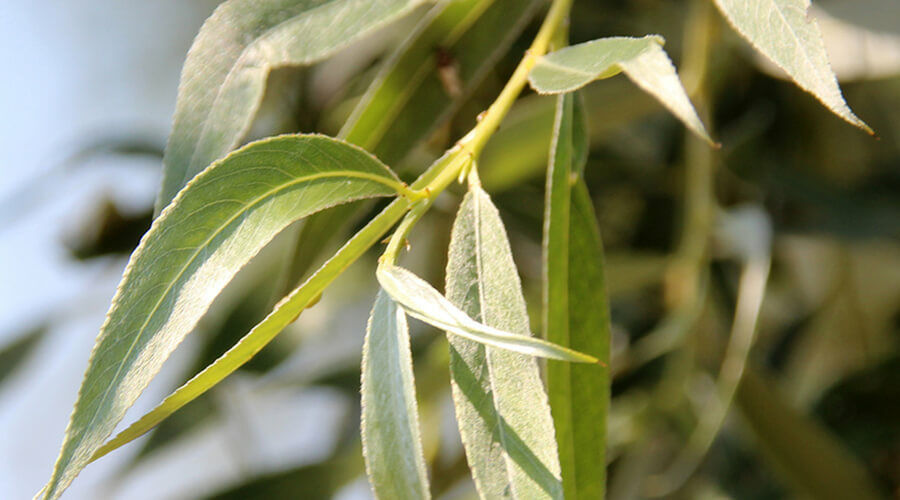
Willow bark, or Salix alba, is used in many different ways today.
Before we get to the positive physiological effects of willow bark, a little history and botany.
Willow has always been very popular. It is even mentioned in the Bible, as the basis of several parables. Its dual symbolism is very well reflected in the texts. Its role is significant not only in the Christian religion, but also in folktales and ancient stories. The story of its naming is also interesting. The species name Salix comes from the Celts, a compound of 2 Celtic words, Sali and Lis meaning near water. This indicates that the willow is very fond of water and marshy places. This is why it is also known in many places as the Queen of Waters. The Greeks held it in high esteem. It is associated with several gods and goddesses.
In ancient times, its healing powers were also recognised.
The willow tree was even popular with poets and artists as the tree of the Muses. In Hungary, the willow tree also appeared very early. It is mentioned in some readings as early as 1001 and is known as a medicinal plant from 1251. Willow bark also has several folk names, such as otter tree, which is attached to it because it is a favourite source of willow. It is also worth noting that it was the English clergyman Edmund Stone who made willow popular in folk medicine. He discovered that willow bark could be used to treat fever.
Willow originated in the northern part of the world.
It is a member of the willow family and has about 400 species in its genus, but there are also hybrids. It is a deciduous tree that can grow to a height of more than 15 metres. The trunk is greyish in colour and the bark is cracked. The leaves are usually scattered, elongated and slightly serrated at the edges. The flowers are yellowish in colour. It has a high moisture and light requirement, which is why its preferred habitats are streams, rivers, marshes and wet meadows. Propagation is usually by shoot grafting or grafting.
The fresh shoots and bark of young willows are harvested. These can be harvested from early spring until the end of autumn. The green bark is much easier to peel off, peeling off the trunk after even a light tap. It is recommended to collect new bark every year.
And now for the physiological effects of willow bark.
The consumption of willow bark tea is highly recommended, especially if you have digestive problems. Willow bark is very good for soothing the stomach and can reduce gastritis and nausea. It can also be a great remedy to relieve inflamed and infected intestines, also has excellent liver detoxifying effects, and is also beneficial for fatty liver and spleen problems. NeverthelessiIt also reduces fever, which is why its use is recommended for flu and colds. It can prevent the formation of blood clots, also has a mild analgesic effect and can calm the nervous system. It also relaxes the uterine muscles and reduces cramps. A strong decoction made from it can also be used against insomnia. It can also reduce menstrual bleeding, headaches and diarrhoea.
And the list doesn’t end here, as it can also be used externally.
A decoction made from it can eliminate gingivitis and disinfect oral wounds. A poultice made from the decoction can also be used to treat boils and inflammation of the skin. It can also be very effective for superficial wounds, as the willow bark poultice disinfects and soothes the wound. Frozen body parts can also be treated with a bark poultice. It is considered a moderately potent hemostatic. If you suffer from athlete’s foot or frequent foot sweating, it can also be used as a foot bath in this case. It is also effective in treating inflamed eyes. It can also relieve rheumatoid arthritis as a rubbing agent.
Now let’s look at some of the shapes to make. Willow bark tea is the most popular so let’s start with that. In 1 cup of water, boil 5 grams of willow bark extract. Strain it and then drink it warm.
Tea infusion against uterine contractions. Steep 5 grams of inflorescence in 250 ml of water for 10 minutes. When the time is up, strain the mixture. It is recommended to drink 1 cup daily and before meals.
Willow bark tea for diarrhoea: Boil 15 grams of willow bark in half a litre of water. Take 1 tablespoon of the brew every 2 hours.
Finally, the contraindications should also be mentioned.
If consumed in large quantities, it can even cause nausea and diarrhoea. Those who are sensitive to salicin should not consume it. Its use should be avoided by those who suffer from asthma or stomach ulcers. It is not recommended for children with fever, nor should be used by pregnant or breastfeeding women. Also not recommended for long-term use and should therefore always be taken as a course of treatment. It should be missed for a few weeks.
We hope you learned a lot about this ancient herb. If you liked this article, share it with your friends!


